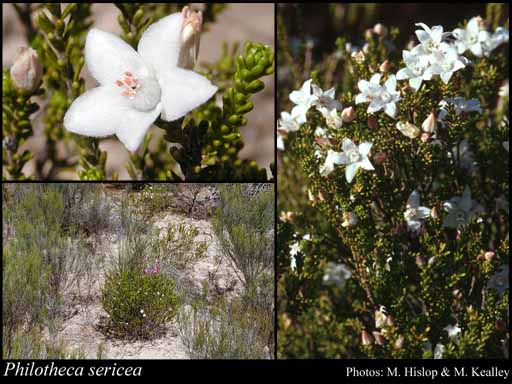- Reference
- Nuytsia 12(2):255 (1998)
- Conservation Code
- Not threatened
- Naturalised Status
- Native to Western Australia
- Name Status
- Current
Erect shrub, 0.3-1.5(-2) m high. Fl. pink-white, Apr to May or Jul to Oct. Sandy & gravelly soils. Lateritic rises & breakaways, granite country.

Scientific Description
Shrub, spines absent; branchlets smooth, without distinct raised glands, +/- cylindrical in cross-section, glabrous. Leaves alternate, simple, 3-5 mm long, 1-1.5 mm wide, flat, the margins flat, verrucose (warty), glabrous; stipular excrescences absent. Flowers terminal. solitary; pedicels 1.6-2 mm long; calyx present, 2-3 mm long, smooth, without distinct raised glands, covered in hairs or scales, the hairs stellate (star-shaped); corolla pink or white or cream, petals five, 7.5-9 mm long, imbricate (overlapping), free, hairy on the surfaces; stamens twice as many as petals, 3.5-4.5 mm long, smooth, hairy; anthers 0.5-1 mm long, with an appendage. Flowers in April, May, July, August, September and October. Occurs in the Eremaean and South-West Botanical Province, in the Yalgoo, Murchison, Coolgardie, Avon Wheatbelt and Geraldton IBRA region(s).
Distribution
- IBRA Regions
- Avon Wheatbelt, Coolgardie, Geraldton Sandplains, Murchison, Yalgoo.
- IBRA Subregions
- Eastern Murchison, Geraldton Hills, Merredin, Southern Cross, Tallering, Western Murchison.
- Local Government Areas (LGAs)
- Cue, Greater Geraldton, Meekatharra, Mount Magnet, Mount Marshall, Murchison, Northampton, Perenjori, Sandstone, Yalgoo, Yilgarn.